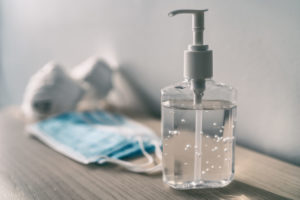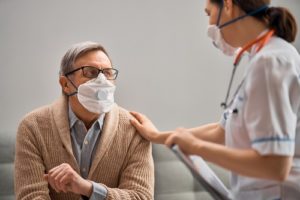Best Practices to Integrate Contact Tracing into Daily Senior Care Facility Operations

Jerry Wilmink, Chief Business Officer at CarePredict
Contact tracing is an essential tool in helping to prevent COVID-19 transmission, and it’s a tool that all senior care facilities need to implement.
While contact tracing is traditionally performed after a COVID-19 case is discovered, this retroactive approach can be flawed. To maximize the chances of quickly containing an outbreak, senior care environments can put contract tracing measures into place in conjunction with their daily facility operations.
The Challenges of Contact Tracing in Senior Care Settings
Contact tracing works to identify all of the people a COVID-19-infected person came into contact with. By identifying the people who are at greatest risk of contracting the virus, appropriate action can be taken to minimize its spread.
The CDC notes that time is of the essence when performing contact tracing after an infection is discovered. Contact tracers need to immediately identify and interview the people who are infected, work to isolate them, and then identify their recent contacts and warn them of their exposure and risk. Because COVID-19 has a two-week incubation period, contact tracing needs to encompass all of the people an infected person has been exposed to over that two-week period.
Contact tracing often relies on a person’s ability to recall where they’ve been over the last two weeks, and that can be a tremendous challenge in a senior care facility. Many residents have memory challenges and the high population density of a facility may mean that a single resident or staff member has come into contact with dozens of others during the two-week period. This means it’s even more important that facilities take steps to implement accurate recordkeeping to supplement memory during the contact tracing process.
Strategies to Integrate Contact Tracing into Senior Care
Because poor memory and other factors can make it difficult to initiate contact tracing after a case of COVID-19 is discovered, facilities need to integrate contact tracing and good recordkeeping into their daily activities. A facility may find that a combination of the following methods provides the most accurate and detailed records:
- Implement a daily sign-in sheet for all visitors, independent contractors, and staff. Record contact information, the time present in the building, and the areas of the facility where each person travels.
- Maintain a detailed logbook of which residents each employee works with on each day.
- Ensure that all facility video cameras are recording, and save the recorded footage. This footage can help to refresh memories and identify contacts within common areas.
The more detailed each of these measures can be, the better.
The Role of Wearable Technology in Contact Tracing
Wearable technology provides a solution to the pitfalls of relying on memory or tracing methods that may not be as comprehensive or detailed as needed. Equipping both residents and staff with wearable technology that tracks their movements in time provides facilities with a detailed record of who any one person has come into contact with.
CarePredict wearable technology was originally designed to help caregivers better monitor changes in their loved ones’ daily patterns, an indicator of potential health risks and challenges. Satish Movva, founder and CEO of CarePredict, identified the need for the technology while caring for his two parents who lived approximately 20 minutes away from him.
While Movva saw his parents regularly and kept in contact by phone, he noticed fluid buildup in his father’s ankles during a visit. Neither of his parents had noticed the issue, which could lead to cardiac issues. Movva designed CarePredict to help families and caregivers better recognize signs of trouble and implement early intervention to keep seniors safe.
CarePredict, a wrist-worn device, provides detailed insights on each wearer’s activity, location, and habits. It provides caregivers with actionable insights, alerting them to differences from the resident’s typical activity patterns. It’s equipped with two-way audio communication between the caregiver and resident, and can even be used to unlock doors.
This wearable device has already proven to offer senior care facilities many benefits. A study published in JMIR Aging found that such detailed monitoring helped facilities to minimize hospitalizations and falls. The two-year study analyzed data from 490 residents throughout six communities. The communities using CarePredict had a 39% lower hospitalization rate and a 69% lower fall rate.
When the pandemic occurred, the CarePredict team realized that the device’s ability to track the wearer’s location could be a valuable asset in contact tracing. The hardware, real-time location system, wearable devices, and beacons were already in use, so the team set out to develop PinPoint, the digital contact tracing software that pairs with the device. Jerry Wilmink, Chief Business Officer at CarePredict, notes that the team created the software in just two to three weeks, deploying it to all customers for free.
With CarePredict’s contact tracing, facility staff can quickly identify all of the residents, staff, and visitors who were exposed to a carrier. The software identifies contacts as high-priority or low-priority, depending on their risks from exposure.
CarePredict’s location tracing helps staff identify the places and locations that were exposed to a carrier. This is particularly important when identifying contaminated surfaces that could spread the virus.
Additionally, the decontamination plan feature allows staff to identify hotspots and areas that a carrier has visited that receive high traffic, like common rooms. With this knowledge, staff can better focus disinfection and decontamination efforts to help minimize the spread.
“The value of CarePredict has been incredible,” explains Wilmink. “With contact tracing in senior living, the key is to be efficient, fast, and accurate in order to stop the chain of transmission. Testing is important, but you can’t test everybody every day. In reality, you need a way to be more surgical. If there’s an infection, you run our software, quickly identify the individuals who came into contact with an infected person, and put your resources on those individuals.”
Establishing Contact Tracing Preparedness
When it comes to contact tracing, a facility’s ability to move quickly and efficiently can be key to preventing COVID-19 spread. Solutions like CarePredict and wearable technology can enhance the speed and accuracy of contact tracing, but they need to be implemented proactively. Investing the time and energy in identifying the best solution for a senior care facility can help to save lives if a resident, staff member, or visitor does contract COVID-19.

Paige Cerulli is a contributing writer to i Advance Senior Care.
Related Articles
Topics: Administration , Departments , Featured Articles , Infection control , Operations , Resident Care , Risk Management , Technology & IT , Wearables










